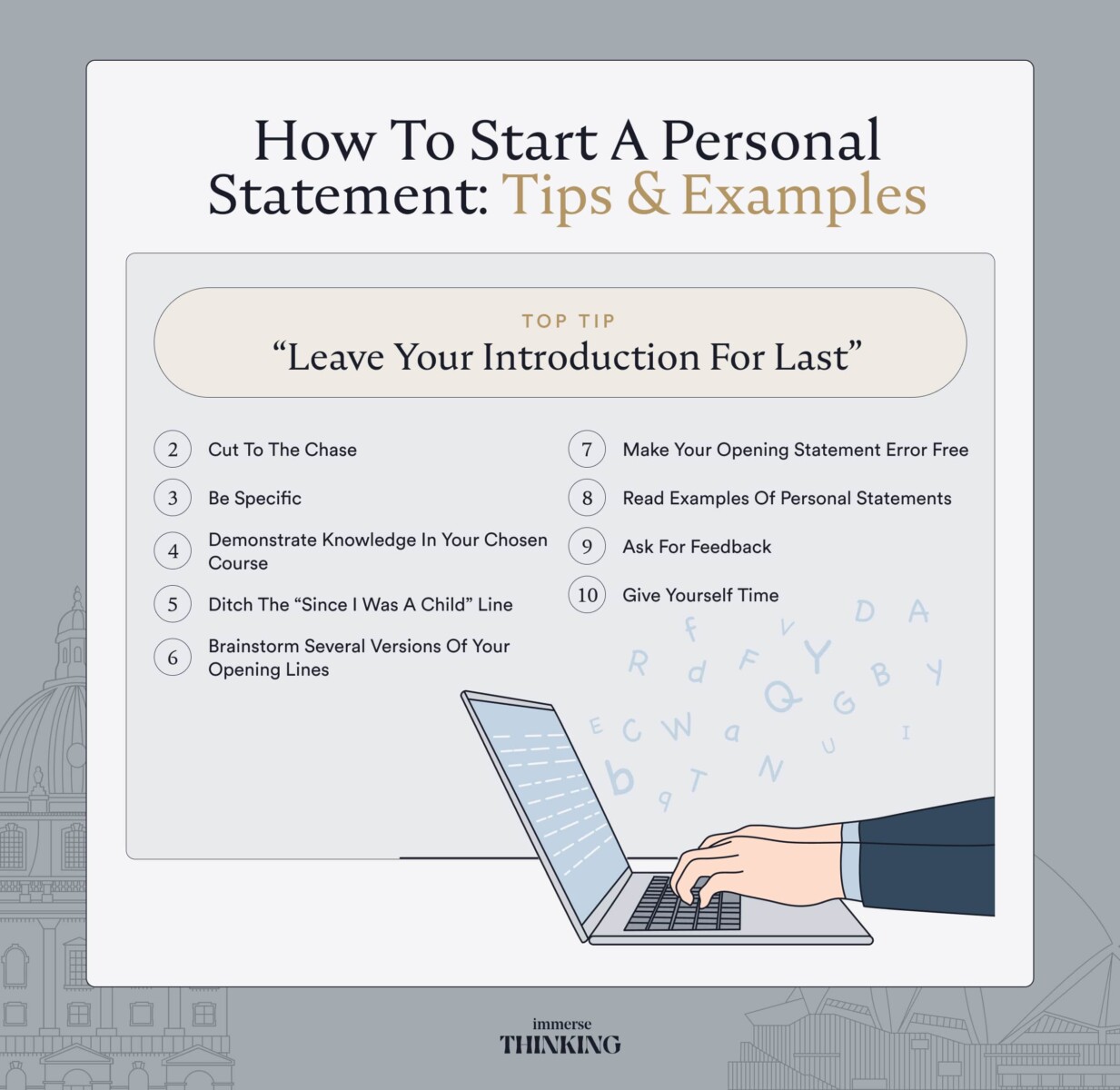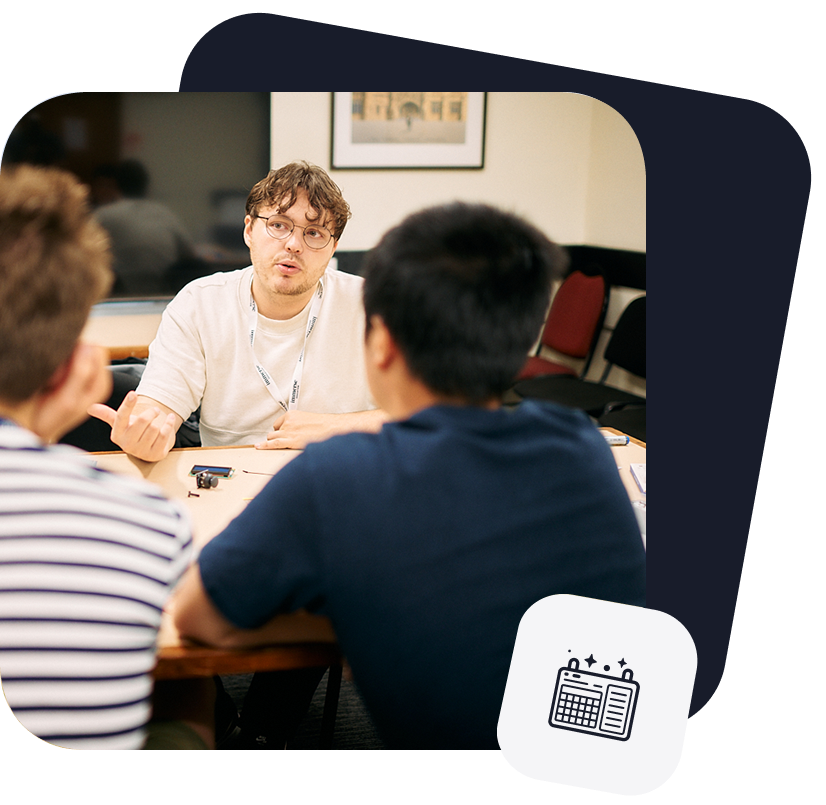Home › University › How To Write A Personal Statement? 10 Tips + Student Questions Answered › How To Start A Personal Statement: Tips & Examples

How To Start A Personal Statement: Tips & Examples
- Published January 20, 2023

We’re regularly asked the question “ how to start a personal statement ”? It’s a challenging task for anybody but worry not as we’re here to help guide you through the process.
The introduction is the first thing the admissions committee will read. That’s why the first sentence of a personal statement should be a catchy, attention-grabbing hook or story that grabs the reader’s attention and sets up the main point of your essay.
A lacklustre introduction may lose your readers’ interest, preventing them from reading the rest of your personal statement!
But don’t worry, this article will guide you on writing a personal statement introduction, a few examples of opening sentences and how to captivate the admissions tutors. Without further ado, let’s get started.
Top Tip: Leave Your Introduction For Last
You know what they say, the hardest thing to do is start . So skip the introduction for now and focus on the main body of your personal statement. If you’re not sure what your main content should be, read out how to write a personal statement guide.
After nailing down the main points, you’ll have a concrete idea of how your introduction can captivate the reader and stay relevant to the bulk of the writing. Go ahead and work on the rest of your personal statement.
Come back when you’re finished! And if you’re worried about your conclusion then check out our advice on personal statement conclusions .
2. Cut To The Chase
You only have 4,000 characters to sell yourself as an ideal student candidate. Make each character and paragraph count! That means forget about flowery words and directionless statements. When you start your personal statement, explain your motivations for choosing your course in one or two sentences.
Although you will discuss this in-depth in the main body of content, capturing your reader’s attention with a quick overview of why you’re enthusiastic about your chosen course is crucial. That’s why capturing the reader’s attention by jumping straight to the point is key to starting a personal statement.

3. Be Specific
Never give vague details when expressing why you want to pursue your course. “I always wanted to be an engineer since I was a kid,” or “I want to become a doctor because I enjoy science” isn’t advised.
On that note, if you’re applying to medicine refer to our guide on how to write a medical personal statement . We suggest being more specific than that, and you can include your academic achievements too. Here are a few suggestions that may help you:
- You witnessed an inspirational figure in your life solve a massive problem with a specific skill set (doctor, engineer, etc.)
- While you were at a charity event, you encountered a problem that kept people in deprivation. By pursuing this course, you’re a part of the solution.
- You’re good at, and you enjoy a specific skill set. The course you’re eyeing puts great emphasis on this particular skill.
- There was a moment in your life when you succeeded in solving a problem. You felt significant by doing so, and you want to keep doing that for the rest of your life (teaching poor children how to read)
- You watched a movie or read a book that ignited your passion for the course. After doing volunteer work or part-time employment related to your course, you’re determined to pursue it.
Craft a sentence or two that encapsulates the core of your “why.” Do this, and your reader will want to read more!
4. Demonstrate Knowledge In Your Chosen Course
An essential element of starting a personal statement is to express why you’re enthusiastic about taking your chosen course. You need to demonstrate that you’re aware of what you’re getting yourself into in the process. Answer any of these prompt questions for inspiration:
- What do you find interesting about the course?
- How do you believe the course will help you achieve your goals?
- How will you use your chosen course to contribute to society?
- What hurdles do you expect to encounter, and how will you handle them?
Decide which of these questions fits best into the main content of your personal statement . Write your answer in a sentence or two, weave them into your application essay and think about the help you received from your tutors in the past.
5. Ditch The “Since I Was A Child” Line
We’re often asked what not to put in a personal statement and “Since I was a child” is a cliche statement that gets thrown around haphazardly. How many students have said this at least once in their personal statements?
Recalling your childhood passions is a weak “why” for pursuing your course. Why? Because the admissions committee is looking for a relevant and up-to-date reason.
When you were little, you had zero knowledge and little enthusiasm to become successful in your field. You had no idea what skillsets you needed or what other options were available to you.
But if you were to cite a recent event in your life that supports your determination to pursue your course, that screams “educated choice” right there. And that is what the admission committee is looking for after reading hundreds, if not thousands of introductions.
6. Brainstorm Several Versions Of Your Opening Lines
The desire to get it right the first time paralyses you from starting. So permit yourself to write freely. Write as many versions of your opening lines as possible.
Don’t worry about the grammar, spelling, or character count just yet. Type everything that goes off the top of your head. When you’re done, take a look at your list.
Cross out the ones you dislike, and encircle the ones you think have potential. Then start piecing the puzzle pieces together to check out if the intro lines fit with the rest of your personal statement.
If you’ve found three potential opening statements, try reading them aloud together with the rest of your personal statement. Do they flow seamlessly into one another? Make the necessary adjustments. Play around with it until you feel you’ve hit the spot.
7. Make Your Opening Statement Error Free
Your opening statement is your hook line. Spelling or grammatical errors at the start discourage your reader from reading further. If you have errors at the beginning, you’ll most likely have them in your main content!
So make sure your English is simple, flawless, and straightforward. Run your personal statement through a tool like Grammarly to weed out most of the errors.
The Hemingway app is also a helpful tool for checking for passive voice and other writing problems. Take advantage of writing assistant tools, especially if you’re a non-native English writer.
8. Read Examples Of Personal Statements
Read as many personal statement examples as you can. Any that captivated you, keep them in your notes. Figure out why these statements stood out to you compared to the others. What elements can you place in your personal statement?
When reading personal statements that put you off, find out why. What characteristics do they have that elicit a negative reaction from you? List them down, and make sure you avoid them.
After this exercise, you should have a few more ideas about your personal statement introduction.
9. Ask For Feedback
Never underestimate what feedback can give you. Ask your family, friends, and acquaintances about your opening statement. Does your personality shine through? Is it straight to the point? Does it flow smoothly with the main content of your personal statement?
Listen to what they have to say. Jot down important points. You’ll need their feedback to get a second opinion on whether it works for you or not.

10. Give Yourself Time
Your chosen career depends on your college education. And a first crucial step is to convince the admission committee you’re worth accepting into your university. You have to give your personal statement your best shot. Give yourself enough time to brainstorm and think everything over.
You can’t finish a complete, well-written personal statement in a week. Much less overnight!
So make sure you set aside enough time to put your best foot forward. After finishing a complete draft of your personal statement, put it down. Forget about it for a few days. Then come back and reread it.
With a fresh set of eyes, you’ll notice details you may not have seen before! Revise as much as you need.
Do I Need To Write An Introduction For A Personal Statement?
Yes, we recommend writing an introduction for your personal statement as it provides context to the rest of your writing. The introduction is an opportunity to make a good first impression and capture the university admissions officer’s attention.
What is a good opening sentence for a personal statement?
Here are some examples of a good opening sentence for a captivating introduction. Note how it ties into the university degree almost straight away with first-hand experience:
- “Growing up in a small town with limited resources sparked my curiosity and drive to pursue higher education and make a positive impact in my community.”
- “From a young age, I have been fascinated by the intricacies of the human mind and the power of psychology to improve people’s lives.”
- “As a first-generation college student, I am determined to break barriers and pave the way for future generations through a career in law.”
- “My passion for sustainable design was ignited by a volunteer trip to a developing country, where I witnessed the devastating effects of environmental degradation firsthand.”
- “A chance encounter with a blind person and their guide dog inspired me to pursue a career in veterinary medicine, with the goal of improving the lives of animals and their human companions.”
Please do NOT use these in your personal statements, use these to guide you on how you want to start your personal statement.
Can You Open Your Personal Statement With A Quote?
It is a risky move to open your personal statement with a quote and can come across as clichéd or insincere to the university admission officers. However, there are rare occasions when it can work, just make sure the quote relates to your degree and experience you’re writing about.
Get Ready To Write Your Personal Statement
How does one start a captivating personal statement? Take the time to think about what makes an effective introduction.
Read examples of personal statements from other students to glean ideas for how yours might stand out. Once you have read through some good ones, they should be more than just two or three!–look closely at what elements made them so successful.
Then try applying those same principles on how to start a personal statement! Don’t forget to bookmark this post for future reference.
Real Alumni Stories
Learn more about our alumni through their success stories.
- Real stories about our Alumni
- Students share their programme experiences
- Case studies from Alumni heading to Oxbridge
- Alumni insights and stats
Empower Your Child's Future: Book Your Complimentary Consultation Now
- Receive tailored advice to match your child's interests and goals.
- Gain insights from our experienced programme consultants.
- Get answers in real-time, making your decision-making process smoother and more informed.

Join Succeed for free: unlock £50 off your Immerse programme*
Succeed is Immerse Education’s student success platform that empowers ambitious learners with tools, content, and interactive resources for university preparation and career exploration.
* Terms and Conditions apply
Download Our Prospectus

- I'm a Parent
- I'm a Student
- First Name *
- Last Name *
- Phone number *
- Which subjects interest you? (Optional) Architecture Artificial Intelligence Banking and Finance Biology Biotechnology Business Management Chemistry Coding Computer Science Creative Writing Criminology Economics Encryption and Cybersecurity Engineering English Literature Entrepreneurship Fashion and Design Female Future Leaders Film and Animation Fine and Digital Art Film Studies Global Society and Sustainability History International Relations Law Marketing and Entertainment Mathematics Medicine Medicine and Health Sciences Media and Journalism Nanotechnology Natural Sciences Philosophy Philosophy Politics and Economics Physics Psychology Software Development and AI Software Development and Gaming Veterinary Studies Online Research Programme
Secure priority enrolment for our new summer school location with a small refundable deposit.
" * " indicates required fields
Receive priority enrolment for new summer school locations by registering your interest below.
Our programme consultant will contact you to talk about your options.
- Family Name *
- Phone Number
- Yes. See Privacy Policy.
Subject is unavailable at location
You have selected a subject that is not available at the location that you have previously chosen.
The location filter has been reset, and you are now able to search for all the courses where we offer the subject.

IMAGES
VIDEO